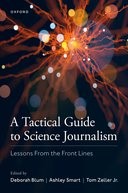Broken Line and Layered Narratives

- Author: Deborah Blum
- Full Title: Broken Line and Layered Narratives
- Type: #snippet✂️
- Document Tags: #sci_comms
- URL: https://academic-oup-com.ezproxy.bu.edu/book/44157/chapter/372344808
Highlights
- Why is it called an inverted pyramid? Picture the triangular shape of an Egyptian pyramid turned upside down so it balances on its peak: big at the top, tiny at the bottom. The key message for news writers is simple. You put the most important information at the top and the least important at the bottom. That way if a reader doesn’t finish the story, you’ve at least delivered the good stuff up top. (View Highlight)
- The broad top represents the lead (or lede), basically the opening sentence, paragraph, or section. Its job is to engage the reader with the story. In the case of the exploding space shuttle, the facts serve that purpose. In the normal, nonexplosive world of standard news stories, the writer needs to be more creative and often less comprehensive to pull the reader in (View Highlight)
- In the next step, the writer continues with the “so-what section,” or what journalism insiders sometimes call “the nutgraf”, which fills in more details, pulls the reader further in, and explains why the story is worth the readers’ time. (View Highlight)
- Then follows what I think of as the “guide section,” which summarizes key issues in the story. Here that includes the history of the disease, the often-crippling symptoms, questions about its mysterious cause, and the public health response. These individual points are then explored in a logical sequence that sets up the story’s ending. (View Highlight)
- The story ends with a “summary point”—yes, now we’re at the bottom point of the inverted pyramid—which may also suggest a resolution. I (View Highlight)
- Those who like geometry will recognize it as a type of rhombus. But what does a rhombus have to do with writing? Basically, it’s a structure that tells you to start a story with a very sharp focus, let it broaden out to the big picture involved, and then bring the story back to the focused point of the beginning. (View Highlight)
- The arc of the story essentially follows that curve. It begins with a conflict, rises to a crisis point, and inclines back down toward a resolution. In Writing for Story, Franklin describes these three points—conflict, crisis, resolution—as the fundamentals of any good story. He also argues that knowing the path from conflict to resolution helps the writer find the story’s primary point of view. (View Highlight)
- The concept is based on the idea of the zippers we use in clothing, which use interlocking teeth to bind two separate pieces of fabric together. The zipper narrative essentially binds two separate but related stories into one interwoven tale. (View Highlight)
- Of course, you can always weave together more than two story threads. A more intricate version is a braided narrative. Named for the traditional hair braid, this approach weaves three story strands together, and apart, and back together. (View Highlight)
